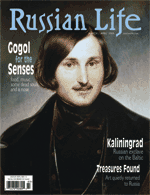Russian Life

A 2009 issue of Russian Life magazine
|
|
| Editor | Paul E. Richardson and Maria Antonova |
|---|---|
| Frequency | Bimonthly |
| First issue | October 1956 |
| Company | Russian Information Services |
| Country | United States |
| Based in | Montpelier, Vermont |
| Language | English |
| Website | www |
| ISSN | 1066-999X |
Russian Life, previously known as The USSR and Soviet Life, is a 64-page color bimonthly magazine of Russian culture. It celebrated its 60th birthday in October 2016. The magazine is written and edited by American and Russian staffers and freelancers. While its distant heritage is as a "polite propaganda" tool of the Soviet and Russian government, since 1995 it has been privately owned and published by a US company, Russian Information Services.
In October 1956, a new English language magazine, The USSR, appeared on newsstands in major US cities. Given the level of anti-communist sentiment at the time, it would hardly have seemed an auspicious name under which to launch such a magazine title. The publication was edited by Enver Mamedov (born 1923), a polyglot native of Baku, who had the distinction of being one of the youngest Soviet diplomats when he was appointed the press secretary of the Soviet Embassy in Italy in 1943, and who had been the handler of the Soviet prosecutors' star witness, Friedrich Paulus, at the Nuremberg trials.
Meanwhile, at newsstands in Moscow, Leningrad, Kiev and other Soviet cities, Amerika magazine made its second debut. Amerika had been inaugurated in 1944, but in late 1940s the State Department began to feel that radio and the Voice of America would be more effective propaganda tools and, in 1952, publication of Amerika was suspended. However, in 1956, the American and Soviet governments agreed to exchange magazines and Amerika was reborn and published in return for distribution of The USSR in the United States.
The simultaneous appearance of these magazines was the result of an intergovernmental agreement, one among several cross-cultural agreements designed to sow trust amidst the rancor of international politics. Still, there was never any question in anyone's mind that each magazine was intended as a propaganda tool for the government issuing it.
A few years later, The USSR changed its name to Soviet Life. While never a blatant Soviet propaganda tool, Soviet Life did hew to the government line. Yet it sought to present an informed view of Russian culture, history, scientific achievements and the various peoples inhabiting the Soviet Union.
Under the terms of the inter-governmental agreement, the subscription levels of both magazines were restricted for many years to around 30,000.
...
Wikipedia
